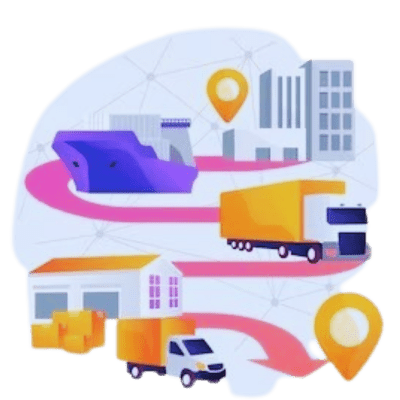What is Transportation & logistics industry
- Freight transportation companies: Trucks, railroads, airlines, maritime shipping
- Logistics service providers (LSPs): Third-party logistics (3PLs), freight forwarding, warehousing, distribution
- Technology companies: Supply chain management software, tracking solutions, freight marketplaces
Goals of T&L Marketing:
- Generate leads and attract new customers: This could involve targeting shippers, manufacturers, retailers, or other businesses needing transportation and logistics services.
- Increase brand awareness and market share: In a competitive industry, standing out and building trust is crucial.
- Promote specific services or solutions: Highlight unique offerings like faster delivery times, specialized cargo handling, or advanced technology.
- Educate potential customers: Inform businesses about complex logistics and transportation options, helping them make informed decisions.
- Build relationships and loyalty: Foster long-term partnerships with clients by exceeding expectations and providing value-added services.

Challenges of T&L Marketing:
- Complex and diverse target audience: Reaching the right decision-makers across different industries can be challenging.
- Long sales cycles: Deals can take months or even years to close, requiring sustained marketing efforts.
- Price-sensitive buyers: Customers primarily focus on cost, making differentiation crucial.
- Technical nature of the industry: Effective communication requires understanding complex logistics concepts and terminology.
Strategies for T&L Marketing:
- Content marketing: Create informative blog posts, white papers, case studies, and infographics relevant to specific industry challenges.
- Search engine optimization (SEO): Optimize website content and online presence to rank higher in search engine results for relevant keywords.
- Social media marketing: Engage with potential customers on platforms like LinkedIn and Twitter, sharing industry insights and company updates.
- Email marketing: Build email lists and send targeted campaigns with relevant offers and information.
- Trade shows and industry events: Network with potential customers and showcase your expertise at relevant industry gatherings.
- Partnerships: Collaborate with complementary businesses to expand reach and offer bundled solutions.
How Transportation & logistics industry is different from other industry
| Feature | T&L Industry | Other Industries |
|---|---|---|
| Complexity of Operations | Very high, involving multiple touchpoints, modes of transport, and stakeholders. | Varies depending on industry, but generally less complex. |
| Stakeholder Diversity | Extremely diverse, including shippers, carriers, regulators, etc. | Varies depending on industry, with some being more international than others. |
| Global Reach | Often operates globally, requiring understanding of international trade and regulations. | Varies depending on industry, but generally less regulated than T&L. |
| Regulation | Heavily regulated for safety, security, and competition. | Important in most industries, but not always the primary focus. |
| Focus on Efficiency & Cost | Paramount due to competitive nature. Requires constant innovation and cost optimization. | Varies depending on industry, with some having a larger impact than others. |
| Impact on Economy | Significant impact on global trade and economic activity. | Important in most industries, but not always the primary focus. |
| Technology Dependence | Highly reliant on technology for optimization, tracking, and process management. | Varies depending on industry, but technology plays a growing role in most. |
| Sales Cycle Length | Typically long due to large contracts and complex negotiations. | Varies depending on industry, with some having shorter sales cycles. |
| Price Sensitivity | Customers highly price-sensitive, requiring focus on value beyond just transportation. | Varies depending on industry, but price is often a significant factor. |
| Seasonal Fluctuations | Demand can vary significantly due to seasonal factors. | Varies depending on industry, but some experience seasonal fluctuations. |
| Environmental Considerations | Sustainability becoming increasingly important, with pressure to reduce emissions and adopt eco-friendly practices. | Varies depending on industry, but environmental considerations are gaining importance in most. |
What is best digital marketing service for Transportation & logistics industry
Key Digital Marketing Services for Transportation & Logistics:
- SEO: Improves your website’s ranking in search results for relevant keywords, attracting organic traffic.
- PPC (Pay-per-click): Targeted ads on search engines and other platforms to drive immediate leads and conversions.
- Content Marketing: Create valuable content like blog posts, case studies, and infographics to attract and engage potential customers.
- Social Media Marketing: Build brand awareness and connect with customers on platforms like LinkedIn, Facebook, and Twitter.
- Email Marketing: Nurture leads, engage existing customers, and promote offers through targeted email campaigns.
- Web Design & Development: Ensure your website is user-friendly, mobile-optimized, and reflects your brand effectively.
Pricing table off SEO (search engine optimization) for Transportation & logistics industry
| Package | Features | Price |
|---|---|---|
| Starter | Keyword research, basic on-page optimization, monthly report | $500/month |
| Growth | Competitor analysis, technical SEO audit, link building outreach, ongoing content strategy | $2,000/month |
| Enterprise | Custom strategy, dedicated account manager, advanced link building, 24/7 support | $5,000+/month |
Pricing factor of PPC (Pay-per-click) for Transportation & logistics industry
| PPC Pricing Factors | Description |
|---|---|
| Campaign goals | Are you aiming for website traffic, leads, conversions, or brand awareness? |
| Target audience | Who are you trying to reach with your ads? (affects keyword competition and bidding) |
| Industry competitiveness | Higher competition means higher cost-per-click (CPC) bids |
| Ad platform | Google Ads, Microsoft Ads, social media platforms have different pricing structures. |
| Campaign complexity | Multiple ad groups, targeting options, and remarketing can increase costs. |
| Management fees | Agencies usually charge fees for campaign setup, ongoing management, and optimization. |
| Desired results | Faster results often demand higher bids and potentially, higher costs. |


